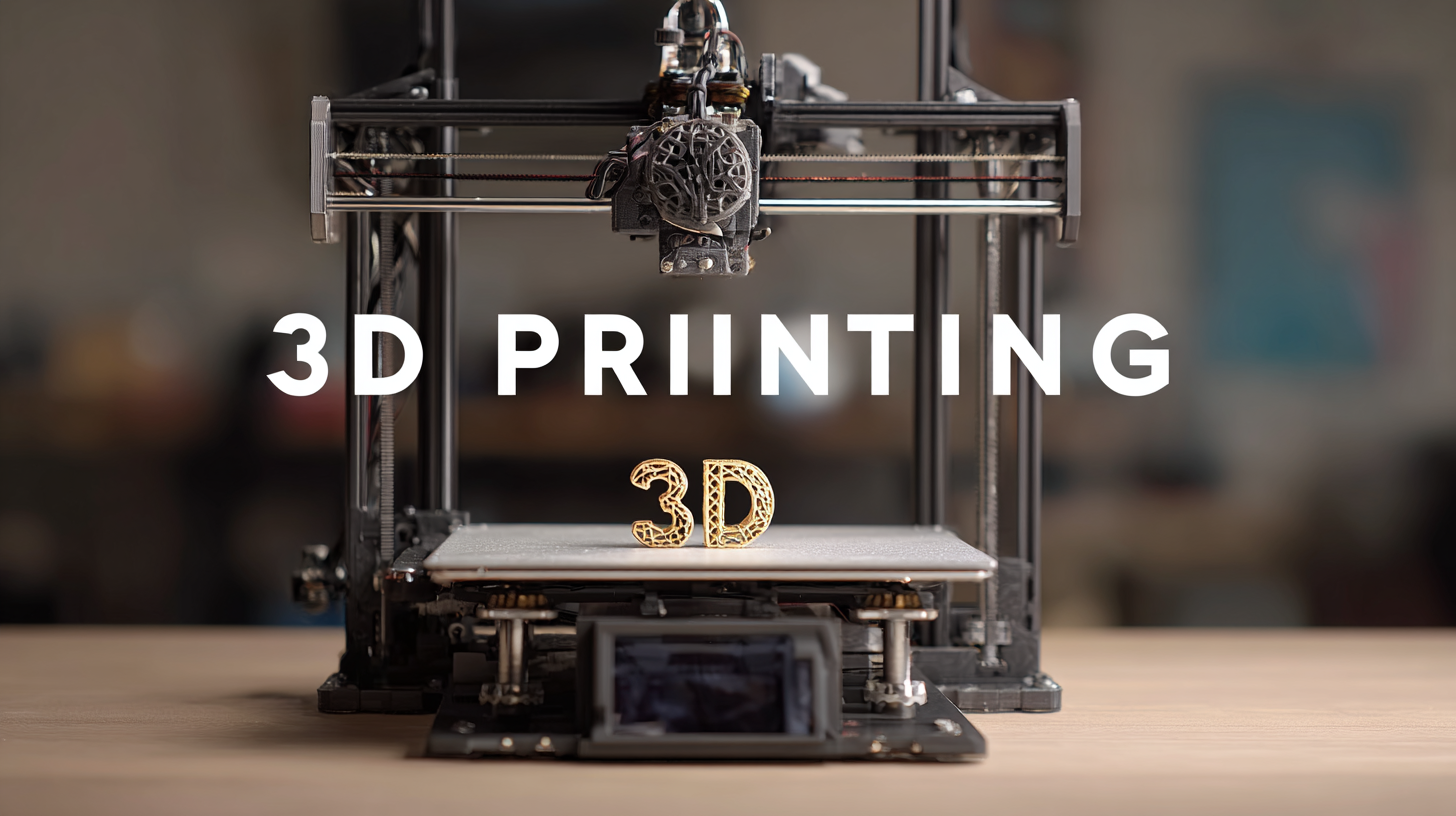Future of 3D Printing in 2025 Essential Trends and Actionable Checklist for Success
The future of 3D printing is set to revolutionize various industries by 2025, as advances in technology underpin the growing adoption of 3D printers. According to the 2023 State of 3D Printing report by IDC, the global market for 3D printing is projected to reach $34.8 billion by the end of 2025, driven by innovations that enhance speed and material versatility.

This transformative technology is no longer limited to prototyping; it is increasingly used for production across sectors such as healthcare, aerospace, and automotive. Furthermore, a study by Wohlers Associates indicates that around 60% of manufacturers are planning to integrate additive manufacturing into their operations in the next few years. As key trends emerge, understanding the technical specifications of 3D printers and developing a strategic approach will be essential for businesses aiming to harness the full potential of this technology.
Key Innovations Transforming 3D Printing by 2025
As we look towards 2025, the landscape of 3D printing is poised for transformative innovations that will redefine industry standards. One of the most exciting trends is the integration of advanced materials. Innovations in biocompatible materials and smart polymers are enabling more complex and functional applications in sectors like healthcare and aerospace. These materials not only enhance the durability and performance of printed objects but also open new avenues for customization and specificity that were previously unattainable.
Another key innovation is the rise of automation and artificial intelligence in the 3D printing process. With AI-driven software, manufacturers can optimize designs for better performance while reducing material waste. This shift towards efficiency and precision will not only cut down production costs but also enable faster turnaround times. Moreover, as digital twins and IoT integration become more prevalent, companies will be equipped to monitor and manage their printing processes in real-time, ensuring consistent quality and reliability. The future of 3D printing by 2025 promises to be not only more efficient but also more versatile, paving the way for groundbreaking applications across diverse industries.
Emerging Materials: Exploring Sustainable Alternatives for 3D Printing
As we approach 2025, the realm of 3D printing is poised for remarkable evolution, particularly in the area of sustainable materials. Emerging materials are not only enhancing the capabilities of 3D printing but also making strides toward reducing environmental impact. Innovations such as biodegradable plastics, recycled filaments, and bio-based resins are paving the way for responsible manufacturing practices. These materials not only meet the functional demands of diverse applications but also align with global sustainability goals.

Incorporating sustainable alternatives into 3D printing processes presents businesses with a dual advantage: they can inspire consumer trust while reducing their carbon footprint. Companies are increasingly prioritizing eco-friendly materials, incorporating locally sourced organic filaments, which minimize transportation emissions. Furthermore, collaborative efforts among researchers, manufacturers, and creatives are vital for developing new, sustainable materials tailored to specific industry needs. As these trends continue to evolve, embracing sustainable materials in 3D printing will undoubtedly be a key strategy for success in the coming years, fostering innovation and environmental responsibility simultaneously.
Integration of AI and Automation in 3D Printing Processes
The integration of AI and automation in 3D printing is set to revolutionize the industry by 2025. As reported by MarketsandMarkets, the global market for AI in the 3D printing industry is projected to reach $1.2 billion by 2026, growing at a CAGR of 23.4%. This growth is driven by the increasing adoption of AI-powered algorithms for quality control and predictive maintenance, which effectively minimize downtime and enhance operational efficiency.
Moreover, advancements in automation technology are enabling a more seamless workflow in 3D printing processes. Companies are now employing automated systems for design validation and material handling, significantly reducing production times. According to a report by McKinsey, firms that integrate AI and automation into their manufacturing processes can improve productivity by up to 25%. As these technologies evolve, we can expect a heightened level of customization and flexibility in 3D printing, allowing businesses to meet the ever-growing demand for personalized products while ensuring cost-effectiveness and sustainability.
Market Applications: Where 3D Printing is Making a Difference in 2025
In 2025, 3D printing continues to revolutionize diverse market applications, extending its impact across industries such as aerospace, healthcare, and consumer goods. A recent assessment indicates that the global 3D printing market is projected to surpass $50 billion by 2025, fueled by the increasing demand for customized products and rapid prototyping solutions. Companies are leveraging advanced technologies, such as ceramic additive manufacturing, to enhance production efficiency and material performance. This trend signifies a shift from traditional manufacturing processes to innovative 3D printing techniques that streamline workflows and minimize material waste.
Moreover, the accessibility of professional-grade 3D printers under $10,000 makes them more achievable for small businesses looking to capitalize on the technology. Today's market offers a variety of options, from color printing to specialized electronic applications, allowing users to choose devices that best meet their operational needs. Reports suggest that the growing interest in 3D printing for industrial applications will only intensify as businesses recognize its potential to reduce costs and time in product development. As we approach 2025, the integration of 3D printing technologies into everyday business practices will undoubtedly reshape the manufacturing landscape.
Future of 3D Printing in 2025 - Essential Trends and Applications
| Application Area | Market Impact | Growth Rate (%) | Key Trends |
|---|---|---|---|
| Healthcare | Personalized Medical Devices | 35% | Bioprinting, Customized Prosthesis |
| Automotive | Rapid Prototyping | 25% | Lightweight Components, Custom Parts |
| Aerospace | Weight Reduction | 30% | Complex Geometries, Fuel Efficiency |
| Construction | Efficient Building Methods | 40% | 3D-Printed Homes, Sustainable Materials |
| Consumer Products | On-Demand Personalization | 20% | Customized Fashion, Unique Gadgets |
Building a Successful 3D Printing Strategy: Essential Steps and Considerations
As 3D printing continues to evolve, businesses must build robust strategies to harness its potential. According to a report by Wohlers Associates, the global 3D printing industry is projected to grow to $40.9 billion by 2024, emphasizing the need for companies to adopt effective practices now. One essential step is investing in appropriate technology. Organizations should assess their specific needs and align their 3D printing solutions—whether fused deposition modeling (FDM), selective laser sintering (SLS), or other methods—with their production goals.
Moreover, integrating sustainable practices into the 3D printing strategy is crucial. A study by the International Journal of Advanced Manufacturing Technology indicates that efficient 3D printing can reduce material waste by up to 70% compared to traditional manufacturing methods. Businesses should consider eco-friendly materials and processes, which not only attract environmentally conscious consumers but also comply with increasing regulations on sustainability. Effective employee training programs are also necessary to ensure staff are well-versed in the latest technologies and responsible practices, fostering a culture of innovation and efficiency within the organization.
